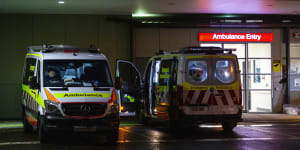NSW Ambulance Commissioner Dominic Morgan said this week that the number of calls paramedics are attending is “genuinely in the unprecedented category”,with ambulances responding to a near-record 116,000 cases in April.

Patients are waiting “longer than ever” for ambulances because of soaring call volume and increased hospital delays.Jessica Hromas
“With surges like is happening now,it can be really difficult to safely move patients through to[emergency departments],” he said,with massive demand on the network resulting in patients “with less severe conditions ... not getting the experience of us that they need”.
Screenshots seen by theHerald show ambulance executive management have asked paramedic crews to work overtime and start day shifts two hours early to “assist with backlog”.
One NSW Ambulance manager,who cannot be named because he is not authorised to speak publicly,said paramedics across metropolitan Sydney are being asked to work up to 16-hour shifts in an effort to “mop up all the calls ambulances haven’t been able to get to overnight”.
Morgan said that,while paramedics are “still[able] to get to immediately life-threatening conditions well within the benchmark”,some less urgent cases are seeing delays in response times as massive spikes in triple zero calls coincide,staff off sick and high numbers of COVID-19 infections in the community.
Brett Simpson,an intensive care paramedic and Australian Paramedics Association representative,said patients were waiting “longer than ever” due to soaring call volume,increased hospital delays and the “sheer number of days we are at status three,where we don’t have enough ambulances to respond to jobs”.
“There can be absolutely no denial[that] patients are at serious risk of severe adverse outcomes,” Simpson said.
Ambulances are consistently ramped - where paramedics are stuck outside hospitals waiting hours to offload patients - at Sydney’s south-east hospitals including St George,Prince of Wales and St Vincent’s,he said.
“In regional NSW,Gosford and Wyong are under a lot of pressure. It’s not unusual to have an entire ambulance fleet stuck at Gosford or Wyong hospitals waiting for beds in emergency departments”.
NSW Health has estimated the state’s ambulance service received an average of 3300 calls per day before the pandemic hit. Last month,the network responded to 116,000 cases,an average of 3860 cases each day.
The pre-pandemic figure from NSW Health is backed up by Bureau of Health Information data that shows in the April to June 2018 quarter NSW Ambulance received about 281,400 calls,or an average of 3090 a day.
Senior doctors are bracing for further pressure on NSW hospitals when winter arrives as pent-up demand after the pandemic,elective surgery backlogs and an influx of flu and other respiratory illness.
One major Sydney hospital said they were opening a 24-hour “fast-tracked emergency department” to manage large numbers of patients waiting longer than clinically recommended for care.
“If patients are low acuity,and they don’t need a formal bed and full admission,they can go into the fast-tracked service. We are now expanding the hours so the service can run overnight because we are seeing are so many patients arrive late into the evening that are waiting too long for care,” one senior emergency specialist said. “Sick leave is the highest it’s ever been,and we are trying very hard to recruit staff”.
Health Services Union national president Gerard Hayes said ambulance ramping was one “symptom of a broken health system”.
“We need at least 2000 extra paramedics to be able to cope with rising demand,” Hayes said.
On Tuesday,NSW Health Secretary Susan Pearce said that “many things[have been done] to reduce the pressure on the ambulance service including our Virtual Clinical Care Centre which enables expert support for people who might call that triple zero line”.
A spokesperson for NSW Ambulance has previously said the network has one of the “largest ambulance workforces in Australia with more than 6000 staff and one of the largest and most modern ambulance fleets in the world”.
“NSW Ambulance will always look to identify different strategies to provide the most timely out-of-hospital emergency care to the community,” the spokesperson said.
The Morning Edition newsletter is our guide to the day’s most important and interesting stories,analysis and insights..